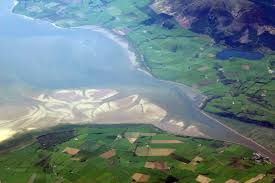Habitat
 Tiger
sharks have habitats that are usually very unpredictable
(Fitzpatrick et al., 2012). They have been spotted as far north as Iceland as as
far south as Uruguay (Marinebio,
2013). But, wherever they are in the world, they are mainly
found in murky water or found in river estuaries, coral reefs,
and lagoons, but can also be found at depths of 350 meters at
times (Marinbio, 2013).
Tiger
sharks have habitats that are usually very unpredictable
(Fitzpatrick et al., 2012). They have been spotted as far north as Iceland as as
far south as Uruguay (Marinebio,
2013). But, wherever they are in the world, they are mainly
found in murky water or found in river estuaries, coral reefs,
and lagoons, but can also be found at depths of 350 meters at
times (Marinbio, 2013).
With
such a large range of habitat, the migration pattern of tiger sharks
is not fully understood, but the temperature of the water seems to
have a large impact on the sharks as they are frequently found in
warmer locations (Edmunds,
2008). Although it is still unknown whether they move
strictly because of temperature, or because of the amount of food
available (Edmunds,
2008). It is known that the tiger shark has adopted the same
type of habitat as large
sea turtles, which is one of the main food
sources for the tiger shark (Witzell, 1987). Whatever the
reason is for these migrations, once one of these
sharks leaves a particular site for another one, the time for return
is very irregular, ranging from 2 weeks- 10 months (Edmunds,
2008).
An experiment that further showed the unpredictability of
tiger shark migration was conducted in 2012 on an island off the
coast of Australia where a large population of sea turtles lay their
eggs (Raine island). The researchers wanted to see if there would be
an increase in tiger shark numbers while the turtles are laying
there eggs (Fitzpatrick et al., 2012). While some sharks seemed to
stay around the island for a longer period of time during this
event, there wasn't enough evidence to say that the tiger sharks
migration patterns were due to the sea turtle movement (Fitzpatrick
et al., 2012).
Another experiment suggested that tiger sharks use cognitive
mapping when they move from site to site (Meyer et al., 2010). This
could explain why the migration patterns of tiger sharks is so
unpredictable. The cognitive mapping may arise from the exploration
patterns of an indivual shark and can also possibly explain why
Researcher found that some would stay at one site all year, while
others would travel thousands of kilometers (Meyer et al., 2010).
Since the
tiger shark is frequently found in shallow waters, human encounters
happen frequently when compared to other sharks. Part of the reason
for these attacks could be explained by man's expansion of
civilization. This is very noticeable in Recife, Brazil, which has
reported some of the highest rates of shark attacks in the world
(Hazin et al., 2013). This happens for a couple of reasons, the
first being from the destruction of the tiger shark's habitat (and
many other organisms such as the
Atlantic spotted dolphin and
hammerhead sharks) from man made
 structures
such as ports, forcing the tiger shark to migrate to the beach areas
(Hazin et al., 2013). Another reason is because of ship traffic in
certain areas. Tiger sharks have been known to follow large vessels
around and if these ships are going past beaches, there will be an
increase of shark populations in those areas. There are a few
hypotheses why sharks do this, one being that ships often times
throw garbage overboard, giving the sharks an easy meal (Hazin et
al., 2013).
structures
such as ports, forcing the tiger shark to migrate to the beach areas
(Hazin et al., 2013). Another reason is because of ship traffic in
certain areas. Tiger sharks have been known to follow large vessels
around and if these ships are going past beaches, there will be an
increase of shark populations in those areas. There are a few
hypotheses why sharks do this, one being that ships often times
throw garbage overboard, giving the sharks an easy meal (Hazin et
al., 2013).
Even with the high attack rate in Brazil, the number of
attacks worldwide are still relatively low. From 1580-2012, there have
been 100 reported tiger shark attack, 71 of which were not fatal (Knickle, 2013).
These attacks still
unfortunately give sharks of all kinds a bad reputation. This bad
reputation has consequently caused shark populations to drop from
the over fishing of them (Marinebio,
2013).
But we must change the publics opinion for the health of the
ocean because sharks are responsible for keeping the ocean running
properly. Being an apex predator, they remove the weak or sick fish,
feed on dead carcasses, keep populations healthy by stopping the spread of disease,
and ultimately keep the ocean populations in line (Sharksavers,
2013). Removing these creatures from the ocean would lead to
devastating consequences on species as small as an
ostracod to even animals that only spend part of their time in
water such as a
harbor seal (Sharksavers,
2013).
December 2013